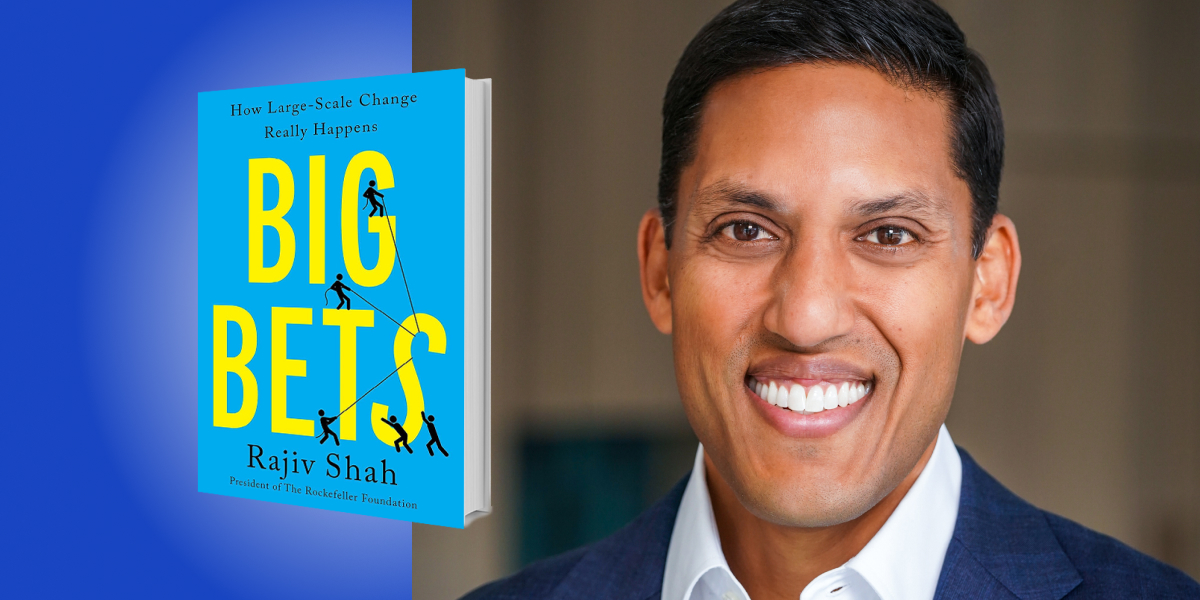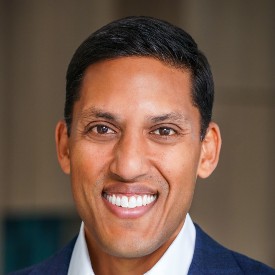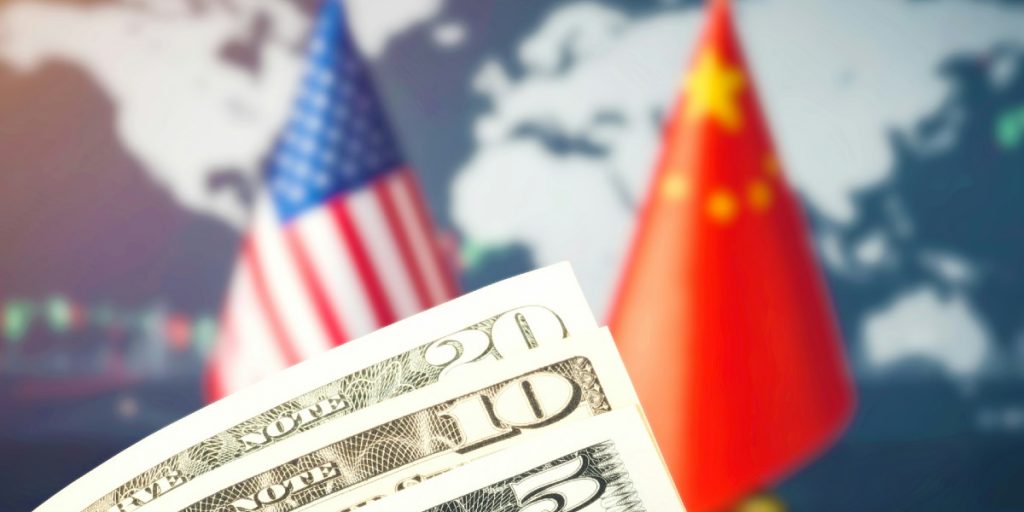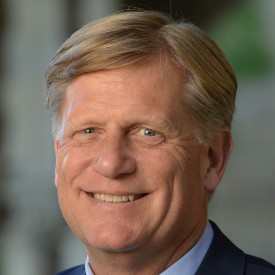Dr. Rajiv Shah is the president of the Rockefeller Foundation and a former American government official, physician and health economist. He was the administrator of USAID and he serves on President Biden’s Defense Policy Board.
Below, Rajiv shares five key insights from his new book, Big Bets: How Large-Scale Change Really Happens. Listen to the audio version—read by Rajiv himself—in the Next Big Idea App.
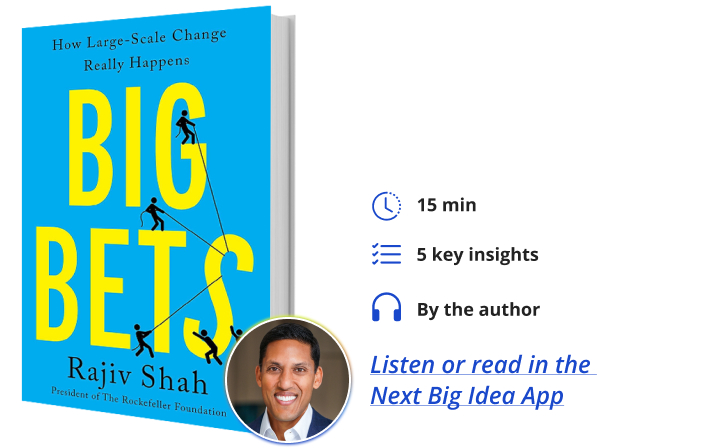
1. Have a “big bet” mindset.
A “big bet” mindset can help actually solve many of the tremendous challenges we face today; however, it can also serve as an antidote to cynicism—the cynicism that curtails our ambitions and makes us powerless. When people try to tackle some of the big challenges we face, there is a natural tendency to feel small or powerless relative to the scale of what we’re up against: fighting climate change, eradicating poverty, overcoming a pandemic. This feeling is known as the “aspiration trap.” It can make you aim too low or settle for the idea that doing good is good enough. However, large-scale change is really only possible with “big bets” that drive you to find new solutions, make unlikely partnerships happen, and measure results.
When COVID-19 emerged, the Rockefeller Foundation team pivoted their existing strategies and programs to help the United States and countries around the world respond. They identified an important solution—testing—because the only way to bend the curve on a pandemic was to find out who was positive and where. However, in April 2020, only PCR tests were available and those took three days or more to return results. At that point, U.S. Labs were performing 23 tests per million people, while South Korea was running 3,600 tests per million.
To help dramatically increase the production of tests in the United States, the Rockefeller Foundation released a report that called for more than tripling the administration of tests, from fewer than one million a week in early April to more than three million a week by the end of June and nearly 30 million a week by October. Together with their partners, they outlined the clear steps to achieve those goals. They built alliances of unlikely partners to grow support for this approach to testing and they pulled together a network of scientists, doctors, teachers, administrators, economists, and government officials to design testing protocols. They even brought Trump administration officials and teachers unions together to pilot those protocols in schools so kids could safely return to their classrooms. Along the way, they measured what was working and responded to what wasn’t. Within a year, the United States had the testing, production, and protocols needed to get students back into school. That’s the kind of large-scale change a “big bet” can make.
2. Ask simple questions.
When you’re searching for a solution, asking simple questions can cut through complexity and lead you to the answers you need. As Bill and Melinda Gates were setting up their foundation, they read an article in the New York Times about Rotavirus, a diarrheal disease common in infants and young children. At the time, in the United States very few, if any, children died from it; however, in poor countries, it killed up to 600,000 children every year. Shortly afterward, Gates invested $750 million to kickstart GAVI, a global alliance with the goal of vaccinating the 50 million children born every year who never received routine vaccinations. That investment revealed the complexity of the global vaccine system: a supply side that involved multinational companies, multilateral agencies, intellectual property laws, and variegated policies, as well as a delivery system that involved a patchwork of aid groups, healthcare systems, transportation and refrigeration, and record keeping.
“The barrier to change isn’t caring too little, it’s too much complexity.”
For many, that complexity provided a reason for inaction or inadequate actions. However, Bill used simple questions to cut through that complexity. He asked over and over again how much it would cost to vaccinate a child and therefore how much would it cost to vaccinate all children. In seeking the answer to that question, cracks were revealed in the system, but the answer was found: it cost about $84 to vaccinate a child in a poor country. Higher than hoped, but it showed the way forward, and eventually, further questioning revealed a path to vaccinating children that required finding significant, sustainable inflows of early capital. GAVI worked with partners to create an immunization bond, and through the efforts of many countries, UN agencies, and vaccine manufacturers worldwide, GAVI has immunized more than 980 million kids and saved 16 million lives during the last two decades. Bill would later say, “The barrier to change isn’t caring too little, it’s too much complexity.” Simple questions can maintain a focus on the transformational audacious goals that are the heart of big bets and the answers, while imperfect, can create a roadmap for how to achieve them.
3. Make it personal.
When you’re recruiting partners, especially unlikely partners, you have to make it personal. In 2014, I was asked to speak at the annual National Prayer Breakfast. It was an exciting opportunity, but I was more than a little nervous—Mother Teresa had given the speech at one point and that’s a tough act to follow. Just a few years before, I had upset many Republicans by accurately pointing out that a budget proposal in the United States Congress to cut USAID would kill 70,000 children in developing countries by reducing the size of life-saving malaria, vaccination, and maternal health programs. Those comments were based on USAID data at the time, but I did not deliver them with respect or in a tactful manner. While many progressives hailed my statements and invited me onto cable news, my comments had understandably upset a lot of Republican leaders, including the Speaker of the House.
I had a choice, I could double down on partisan praise, or I could visit with those I offended, apologize, and learn about their personal values and commitments to our cause. I chose to make it personal. I worked to get to know what drove lawmakers’ interest in the issues, I spent time with them often traveling to their home districts or abroad, and I shared my own values and concerns, and we prayed together. In just a few years I found many committed, if unlikely, allies in an increasingly polarized Washington. When I urged people at the Prayer Breakfast to come together as good Samaritans to end extreme poverty, people of both parties stood up and cheered.
In the years that followed, conservative Republicans and progressive Democrats co-sponsored and passed important legislation to reestablish America as the world’s humanitarian leader. I learned that opening up, being vulnerable, and making it personal was a path to building authentic relationships and trust: the most important elements of true collaborations.
4. Measure the results.
When you’re working on a big bet, you have to build experimentation and evaluation into everything you’re doing, and you can only do that if you’re focused on measuring results. Doing good is not good enough; you have to figure out how to track, share, and analyze data.
During the fight against Ebola in West Africa in 2014, we were facing a huge problem. The Centers for Disease Control and Prevention (CDC) estimated that there could be as many as 1.6 million cases and that the pandemic could go global. A disease that causes a deadly hemorrhagic fever could spread around the world. The president and his team made a big bet—they would deploy U.S. troops and first responders into West Africa to beat back the pandemic there, to save lives and prevent it from spreading globally.
“Doing good is not good enough; you have to figure out how to track, share, and analyze data.”
However, nobody knew exactly how to do that and the only previously validated solution, building Ebola treatment units and isolating people who were positive, was not going to work. They needed new solutions, but to find them they first had to build a data system that allowed them to know who was sick and where quickly. They deployed Bioterrorism Laboratories, used helicopters to transport blood samples, and asked young people on motorbikes to quickly confirm potential case reports and text them with their observations. They put all of the data, even imperfect data, into a dashboard so everyone could operate with the same information, and they asked local communities to help design new solutions.
They soon learned that carefully constructed burial teams could remove the bodies of those deceased, preventing 70 percent of the spread of the disease. Instead of 1.6 million cases, they ended Ebola in West Africa with just under 30,000 and prevented its further spread. Having the right data quickly proved critical to experimentation and problem-solving in a fast-moving and deadly operating environment. Big bets require a commitment to measuring results in real time and learning from the data collected.
5. This work will change you.
Working to make the world a better place changes you more than you might change the world. The best thing about working on big bets is that it can make life rewarding in a deeply personal way. It’s easy to be cynical, to think you cannot make a difference—until you learn you can.
I was deeply inspired when, as a child, Nelson Mandela visited Detroit on his triumphant U.S. tour after being released from prison. I remember sitting on my family’s couch in our living room, watching every minute of the coverage of the visit, including his amazing speech at Tiger Stadium. As I watched the visit, I realized that I wanted to do something meaningful with my life. I had no idea what that meant, how to do it, or if I had what it took but decades later, I took my kids to Robben Island to visit the prison in which Mandela lived for 27 years. I have learned that you do not have to be Nelson Mandela to make a difference in the world, you have it within you to solve the problems we face, and just trying to do so will change your life for the better.
To listen to the audio version read by author Rajiv Shah, download the Next Big Idea App today:












